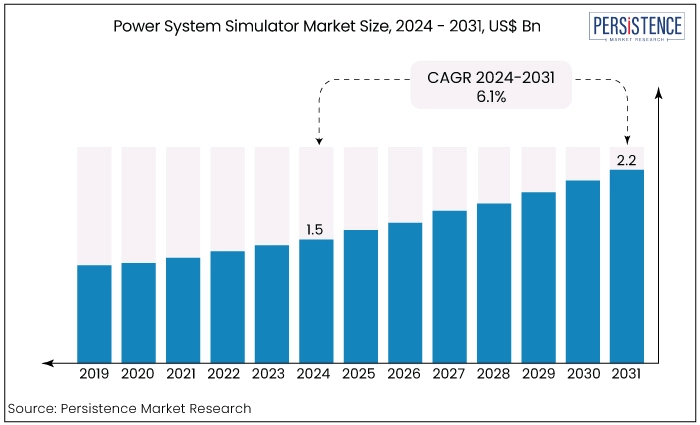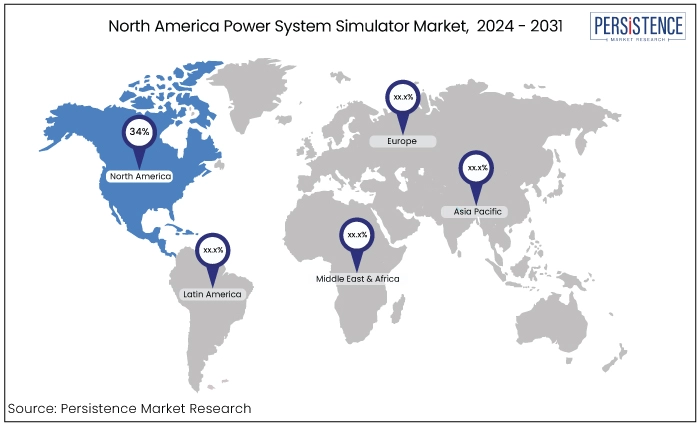Industry: Industrial Automation
Published Date: September-2024
Format: PPT*, PDF, EXCEL
Delivery Timelines: Contact Sales
Number of Pages: 166
Report ID: PMRREP34775
The power system simulator market is estimated to increase from US$1.5 Bn in 2024 to US$2.2 Bn by 2031. The market is projected to record a CAGR of 6.1% during the forecast period from 2024 to 2031.The advent of IoT and artificial intelligence in the power systems is one of the crucial market driving elements shaping the market’s growth trajectory over the forecast period.

Key Highlights of the Market
|
Market Attributes |
Key Insights |
|
Market Size (2024E) |
US$1.5 Bn |
|
Projected Market Value (2031F) |
US$2.2 Bn |
|
Global Market Growth Rate (CAGR 2024 to 2031) |
6.1% |
|
Historical Market Growth Rate (CAGR 2019 to 2023) |
5.7% |
|
Region |
Market Value Share 2024 |
|
North America |
34% |
North America market to account for about 34% of the revenue. The market's expansion in the region is credited to the substantial expenditures made in the region's smart grid infrastructure. Considerable investments are being allocated towards the development of smart grid technologies that integrate sophisticated sensors, communication networks, and automation systems.
Power system simulators play a crucial role in the design and testing of smart grid components prior to their widespread implementation. The market in the United States is projected to experience a CAGR rate of 6.2% between 2024 and 2031.
The United States is making significant investments in the renovation of its deteriorating electricity grid infrastructure, which includes the implementation of intelligent grid technology, sophisticated grid management systems, and the integration of renewable energy sources.
Power system simulators are essential for the design, testing, and implementation of these sophisticated systems. In November 2022, the U.S. government disclosed a substantial investment of USD 13 billion to enhance and enlarge the U.S. electricity grid.

|
Category |
Market Share in 2024 |
|
Component - Software |
48% |
The power system simulator market is further fragmented into hardware, software and services, based on component. Among these, the software segment dominates the market. The software segment to account for 48% of global sales.
The segment's expansion is ascribed to the increasing necessity to optimize resources. Simulation software facilitates the optimization of current infrastructure and resources, resulting in decreased operational expenses and improved efficiency.
Sophisticated software allows for predictive maintenance by modelling different situations and detecting potential problems before they result in failures, thus minimizing downtime and maintenance expenses.
Integrating AI and ML into power system simulation software improves predictive capacities, accuracy, and efficiency, making these products more robust and attractive to users. This creates substantial growth prospects for this industry.
|
Category |
Market Share in 2024 |
|
Analysis - Load Flow |
40% |
The power system simulator market is further classified into load flow, short circuit and harmonic based on analysis. Among these, the load flow segment dominates the market.
The load flow segment to accumulate 40% of global revenue. The segment's expansion might be ascribed to guaranteeing grid stability and dependability. Load flow analysis is a crucial process in the planning and construction of power networks. It helps determine the best locations and sizes for power generating, transmission, and distribution assets to ensure the stability and reliability of the system.
The load flow analysis data encompasses computations of voltage drop, power flow analysis, and losses. ETAP, an American corporation, is among the firms that provide Load Flow Analysis Software.
The ETAP Load Flow Analysis Software has extensive capabilities for conducting power flow analysis and simulations. It accurately calculates currents, branch power factors, bus voltages, and power flows throughout the electrical system.
The market is projected to experience significant growth in the forecast future because of the rising demand from the power industry and the increasing technical advancements in the cloud-based Internet of Things (IoT).
The significant growth in the energy industry has increased the global need for power system simulators. The growing intricacy of power systems, resulting from the incorporation of renewable energy sources, distributed generation, and smart grid technologies, has generated a demand for sophisticated simulation tools.
Power simulation tools assist in tackling the difficulties linked to upholding stability, dependability, and robustness in contemporary power networks. Power system studies are essential for the design of electrical power systems. Calculations and simulations are performed to guarantee that the electrical system and its components are precisely defined to operate as intended, withstand expected pressures, and prevent breakdowns.
Power system simulation provides advantages such as increased efficiency, enhanced dependability, cost reductions, and assistance in making better decisions. Simulation aids in the identification of potential problems and vulnerabilities in the power system, enabling preventive actions to improve dependability and avoid power outages.
The power system simulator market has seen steady growth historically due to increasing demand for efficient energy management and the rising complexity of power grids. Pre-2023, the market was driven by growing investments in power generation, transmission, and distribution, particularly in developing countries.
The integration of renewable energy sources, such as wind and solar, into traditional power grids created a need for advanced simulation tools to ensure grid stability and optimize performance. Rising awareness of grid resilience and the push for modernized electrical infrastructure boosted the adoption of power system simulators.
The market is expected to expand further, fueled by the global transition toward smart grids, the rising use of digital twins in energy systems, and advancements in simulation technologies.
Increased government initiatives for energy efficiency and the integration of energy storage systems will also contribute to market growth. The demand for real-time simulations to support grid flexibility and reduce downtime is anticipated to drive a strong compound annual growth rate (CAGR) in the coming years.
Integration of Renewable Energy Sources
The rising adoption of renewable energy sources, such as wind, solar, and hydropower, is a major driver of the power system simulator market. As these intermittent energy sources are integrated into traditional grids, the complexity of managing power flow and maintaining grid stability increases.
Power system simulators are essential for forecasting, planning, and balancing energy production from both renewable and conventional sources. They allow grid operators to simulate different scenarios and optimize grid performance, ensuring a smooth transition to more sustainable energy systems.
With governments globally pushing for increased renewable energy adoption to meet climate goals, the demand for power system simulators to manage these diverse energy mixes is expected to grow significantly.
Growing Need for Grid Modernization
Aging electrical infrastructure and the increasing demand for reliable power supply have created a need for grid modernization, which is driving the power system simulator market. Many countries are investing in smart grids and advanced electrical infrastructure to enhance efficiency, reduce outages, and manage growing energy consumption.
Power system simulators play a crucial role in this modernization process by enabling utilities to model and optimize grid performance before implementation. These tools help identify potential bottlenecks, plan system upgrades, and integrate advanced technologies like automation and digital control systems, thus driving the growth of the simulator market.
Rising Adoption of Smart Grids and IoT
The global shift toward smart grids, combined with the increasing adoption of the Internet of Things (IoT) in energy management is a significant growth driver for the power system simulator market.
Smart grids require advanced simulation tools to manage real-time data from IoT-connected devices, enabling dynamic power flow control and predictive maintenance. Power system simulators help operators analyze vast amounts of data generated by smart meters, sensors, and other IoT-enabled devices to optimize grid operations and improve efficiency.
As smart grid initiatives expand globally, especially in regions like North America, Europe, and Asia-Pacific, the demand for power system simulators is expected to grow, offering enhanced grid flexibility and resilience.
High Initial Costs and Complexity
One of the key restraints in the power system simulator market is the high initial cost of implementation. Advanced power system simulators require significant investment in hardware, software, and skilled personnel for setup and operation.
Smaller utilities or companies with limited budgets may find it difficult to justify such high upfront costs, which can slow down adoption.
The complexity of power system simulation technologies demands specialized knowledge, and the need for extensive training and ongoing maintenance further raises the cost barrier. This financial burden may deter some organizations from adopting power system simulators, especially in developing regions with constrained resources.
Limited Standardization and Interoperability Issues
Another growth restraint for the market is the lack of standardized protocols and interoperability between different simulation tools and grid systems. With multiple vendors offering various simulation technologies, it becomes challenging for utilities to integrate these systems seamlessly.
Incompatibility between simulators and existing grid infrastructure can lead to inefficiencies, requiring additional customization or upgrades. This lack of standardization limits the widespread use of power system simulators and creates challenges for companies looking to implement them across diverse regions or operations.
Expansion in Developing Economies
A key opportunity for the power system simulator market lies in the expansion of power infrastructure in developing economies and emerging markets. As countries in regions such as Asia-Pacific, Latin America, and Africa undergo rapid industrialization and urbanization, the demand for reliable, efficient power systems is surging. These regions are experiencing a growing need for modernized electrical grids to accommodate rising energy consumption and increasing integration of renewable energy sources.
Power system simulators can play a pivotal role in helping these countries design, test, and optimize their power networks, ensuring grid stability and operational efficiency while minimizing costs.
Governments in emerging markets are increasingly focusing on sustainable energy transitions, leading to large-scale investments in renewable energy projects. For instance, countries like India, China, and Brazil are seeing significant growth in solar and wind energy capacity.
Power system simulators offer a critical solution by enabling grid operators to model different energy generation scenarios, balance variable renewable inputs, and improve overall grid performance.
The ability to predict system behaviours and prevent failures through real-time simulation is especially valuable as these regions look to minimize power outages and improve the reliability of their power supply.
International financial institutions and development banks are supporting infrastructure projects in these regions, providing funding for grid modernization and expansion. This creates a favourable environment for power system simulator vendors to introduce their solutions as part of broader efforts to modernize energy systems.
The major competitors in the power system simulator market are primarily evaluated based on their product or service offerings, their financial statements, developments and the approaches implemented, the company's position in the global market scenario and its geographical reach.
The key competitors in the industry employ crucial strategies like partnership deals, mergers and acquisitions, and business expansion deals to strengthen their hold on a particular region or a particular service offering.
Recent Industry Developments in the Power System Simulator Market
|
Attributes |
Details |
|
Forecast Period |
2024 to 2031 |
|
Historical Data Available for |
2019 to 2023 |
|
Market Analysis |
US$ Billion for Value |
|
Key Regions Covered |
|
|
Key Market Segments Covered |
|
|
Key Companies Profiled in the Report |
|
|
Report Coverage |
|
|
Customization & Pricing |
Available upon request |
By Component
By Analysis
By End Use
By Region
To know more about delivery timeline for this report Contact Sales

Growing need for grid modernization fuels the demand for power system simulators.
A few of the key players in the market are Siemens, ABB, Eaton, and the MathWorks, Inc.
The software segment to record a significant market share in 2024.
Expansion in developing economies offers compelling opportunity in the market.
North America is set to account for a significant share of the market.